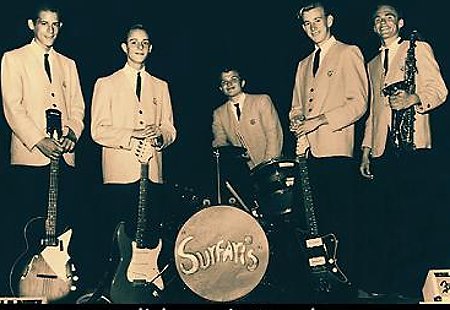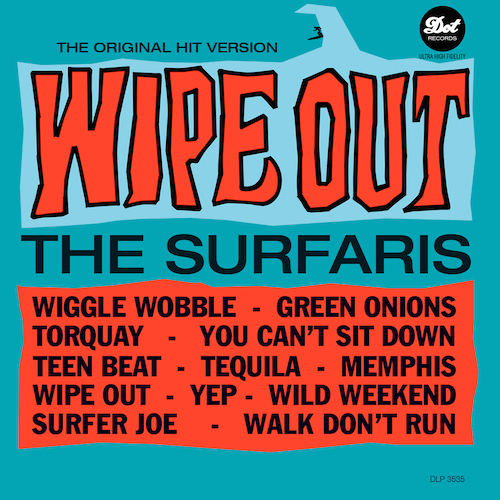 It’s one thing to have been part of a one-hit wonder band, to have made your mark on the record charts and then quietly disappeared into the music history books. But if that one hit was as ubiquitous as “Wipe Out,” the #2 surf music classic recorded by The Surfaris in 1963, and you played the lead guitar on that record, you’re probably more important than those history books let on.
It’s one thing to have been part of a one-hit wonder band, to have made your mark on the record charts and then quietly disappeared into the music history books. But if that one hit was as ubiquitous as “Wipe Out,” the #2 surf music classic recorded by The Surfaris in 1963, and you played the lead guitar on that record, you’re probably more important than those history books let on.
Jim Fuller, that guitarist, died March 3, 2017, at age 69 in Monrovia, Calif. The cause of death wasn’t reported, but Fuller’s passing was confirmed on Facebook by his former bandmate Bob Berryhill and by Fuller’s son, Jay.
Jim Fuller, born on June 27, 1947, is often called “The Godfather of Surf Guitar.” He was an original member of the Surfaris along with Ron Wilson (drums, vocals), Berryhill (rhythm guitar) and Pat Connolly (bass). The band formed in Glendora, Calif., in 1962 as the surf music craze was just emerging and “Wipe Out” was written that winter. A saxophonist, Jim Pash, joined the band after “Wipe Out” was recorded.
Originally released on the small DFS label, it was then picked up by another indie label, Princess Records, before finally finding national distribution with the larger Dot Records. “Wipe Out” was originally intended to be the B-side of the single, with the vocal track “Surfer Joe,” credited to Wilson, as the A-side. But there was simply no way “Wipe Out” was going to be ignored. Cut at Powell Studios in Cucamonga, the record begins with a cracking sound, meant to be a surfboard breaking in half (Berryhill’s dad did the honors). It’s immediately followed by a crazed laugh (that was the band’s manager, Dale Smallin) and a falsetto voice: “ha ha ha ha ha, wipe out,” before Wilson’s trademark drum solo—imitated by countless drummers and, to the chagrin of many high school teachers, students banging it out on their desks—and Fuller’s guitar lead kick in.
Related: What are some of the other great guitar riffs in rock?

That riff quickly became required learning for thousands of aspiring rock ’n’ roll guitarists—for many it was the first they learned—and remains quite likely the most famous surf guitar lead line ever. Both “Wipe Out” and “Surfer Joe” charted, but the latter only hit #62 and “Wipe Out” has gone down as one of the classic rock instrumentals of all time.
The Surfaris charted once more in 1963, with a track called “Point Panic,” also in 1963, and “Wipe Out” itself returned to the Billboard chart twice more, in 1966 and 1970. It’s been featured in dozens of movies and television programs as well as many compilation albums. The Surfaris also recorded several albums, including Wipe Out (Dot Records, #15 in 1963). They disbanded in 1965.
Following the Surfaris’ split, Fuller briefly played with the Seeds, of “Pushin’ Too Hard” fame, then rejoined the Surfaris. The group has come and gone with varying lineups since the ’60s. In recent years Fuller played with a band of his own called Jim Fuller and the Beatnik.
Listen to the original “Wipe Out” by the Surfaris, set to a montage of surf movie clips
The Surfaris’ recordings are available here.


6 Comments
Pretty damned young when he made his claim to fame.
Yes, my Dad was taken too soon. Unfortunately with the main writers passed, the last member has decided to go on a “Look at Me” campaign with lies and half truths. I actually have the testimonials to prove that not to mention my Dad being with the core Surfaris group for a but over 33 years total, I was part of just about every incarnation of this band. Compared to only 6 years or less of the other member.
I was a friend of your Dad in 1961-1969. We went to the same schools and hung out with the same people. He was indeed the ” Godfather of Surf Guitar” There was something unique about his hand, and anyone who knew him was always freaked out by it! So sorry about his passing so soon, but he will always be remembered by us Old Timers
Is Pat Connolly still alive? I know 3 of the others have passed on.
I really enjoyed hearing the story of the creation of “Wipe Out”. We played that song at every venue we worked in our high school rock band in Alaska ‘65-‘67. A nostalgic sound I’ll never forget.
I’ve always identified, what the writer here calls, “a crackling sound,” in the song’s intro, with a Fender amplifier’s reverb tank being rocked back and forth. It’s kind of an unmistakable sound, especially for guitar players of a certain era. Now, I’m not so sure….. Funny how your memory plays tricks on you. I guess that’s just how we did it back in the day. But nobody could cackle like that…. Not even close.